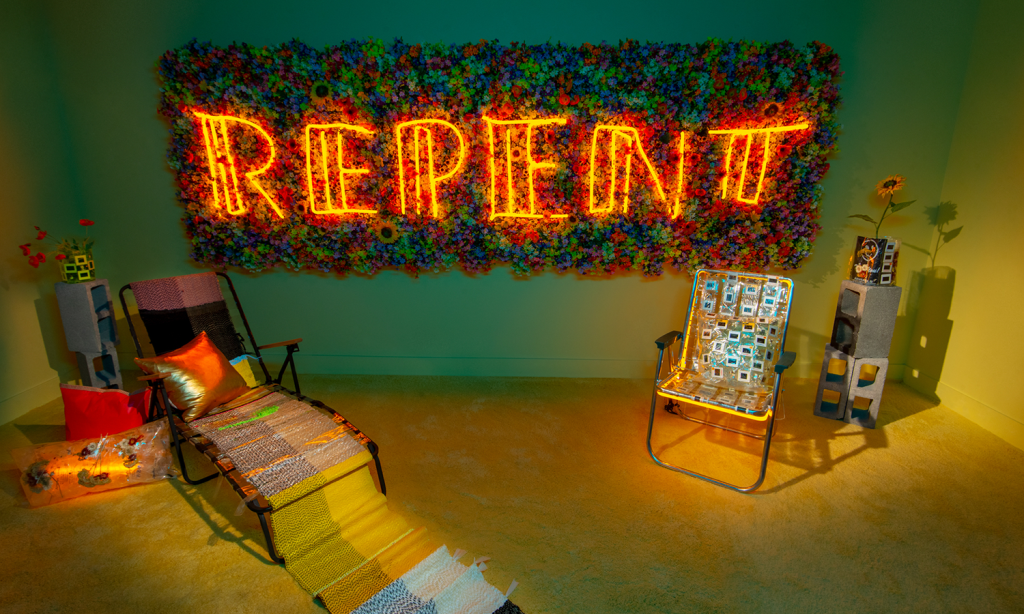Immerse yourself in neon at She Bends: Redefining Neon Legacy
A new exhibit people can now see at the Museum of Glass.
The Ledger would like to offer our thanks to the Musuem of Glass for allowing our writers to view the exhibit and providing us with photo access and credits.
Come and visit She Bends: Redefining Neon Legacy, an exhibit at Museum of Glass that explores how neon is an emerging artform by female artists.
This exhibit features vibrant and interactive elements of the neon works that explore a variety of topics in relation to the artists and their backgrounds such as climate change, resistance and perseverance, commercialism, as well as setting personal boundaries for oneself.
She Bends, founded by artist Meryl Pataky, started off as a survey exhibition in 2017 at the Museum of Neon Art. Pataky felt a need to create the organization as a means of support for female artists after seeing a similar showcase appear in the UK.
“A majority of the roster (at the UK show) were people who didn’t bend the glass themselves, and I was like, man there are so many amazing artists who are experimenting with this medium with their own two hands. They are the women in neon, and we really should be highlighting them,” Pataky said.
What soon followed created a community of glass benders that has led to demonstrations for people interested in working with neon, along with other exhibitions and shows. The “Womxn in Neon” was an exhibition at The Loveland Museum in Colorado that caught the attention of Tacoma’s own Museum of Glass.
“We were intrigued by the concept and were interested in exhibiting neon a little more extensively than maybe we have in the past. Museum of Glass always seeks opportunities to represent our entire community through the stories told in our galleries. The more we in the glass community have experiences with adjacent art forms like neon, the more we can present an immersive and compelling narrative to our visitors,” said Marketing and Communications Director for Museum of Glass, Tim Butler.
Pataky and her co-founder of She Bends, Kelsey Issel, after being contacted by Museum of Glass, began an 8-to-9-month long process that allowed Issel and Pataky to custom curate the presentations and the artwork that would be showcased. This allowed more freedom for art installations to be hidden behind walls, platformed or interactive for the visitors.
Pataky has a couple pieces in the exhibit. One that may stand out to visitors is “A Modern Guilt,” a yellow and orange-hued room that features two plastic lawn chairs covered in pictures, plastic and flowers. Behind the chairs is a wall covered in flowers with a brilliant neon sign that gives the room its color. The message on the sign reads “REPENT.”

“It’s a very domestic scene with this jarring message. Most people are accosted by it because how it is rooted in Christianity… but really what the word repent stems from is just an existential change, just making a change for yourself,” Pataky said.
The piece is a collaboration with Allie Felton, a textile artist who helped make the pillows, lawn chairs and planters all out of recycled materials.

The piece itself is about the climate crisis, but also explores motherhood and the anxieties that come with raising a child in an ever-changing world. Additionally, trying to be responsible and sustainable under these pressures.
This art piece was created at an interesting time for Pataky, who had started making it back in 2020 and was designed for a solo exhibition in April of that year. Due to the pandemic, this exhibit was postponed until the fall of 2020. When Pataky was finally able to install the piece, the meaning of it became ever clearer.
“The fall of 2020, we had an enormous amount of wildfires; the sky turned orange. We had an entire day where we did not see the sun, the whole sky and everything was dark all day long… It was the day that I installed that work at the gallery was the day that happened, and it was the exact same color (as A Modern Guilt),” Pataky said.
Pataky has other featured works such as “Ru’ach” which is now a part of Museum of Glass’ permanent collection and visitors will see it moved throughout the museum once the exhibit closes.
Another artist featured at the exhibition is Canadian-Palestinian artist Jude Abu Zaineh, whose piece “tend to grow (watermelons)” has been featured at the Institute of Contemporary Art in San Francisco. One can spot the piece immediately as it has been featured in highlights and adverts for the exhibition.
The installation features a wall of neon watermelons, some in different shades and colors, but all share the same meaning of representing the colors of the Palestinian flag, which is illegal in occupied lands of Palestine. Watermelons are a staple fruit for Palestinians and the fruit symbolizes resistance and perseverance, as Zaineh has shared in artist statements.
“This piece, ‘tend to grow’ is an important marker for human rights and basic human justice… I think this piece is a testament to these unjust power dynamics that exist. Thinking about dismantling oppressive, colonial, white supremacist powers,” Zaineh said.
While this piece is a reflection on Zaineh’s own experience as a Palestinian, she believes that many different groups can relate to “tend to grow (watermelons)” through the lens of those who are denied basic human rights whether it be through race, gender inequalities, or other marginalized communities.

Pataky hopes that people who view the exhibit will not only see the messages that her fellow artists are showcasing but can also appreciate neon as a fine art, refreshing its history of primarily functioning as signage for commercial businesses. Pataky wants people to see the artists behind the bright neon.
“More than anything, people don’t understand what goes into this at all. Hardly anybody has seen a neon sign be made. Nobody knows what we go through or what we spend. We cut, we bleed, we burn,” Pataky said.
She Bends: Redefining Neon Legacy is on view now at Museum of Glass until October, 2023. You can find more about She Bends at https://www.shebends.com/ or follow them on Instagram @Shebendsneon



